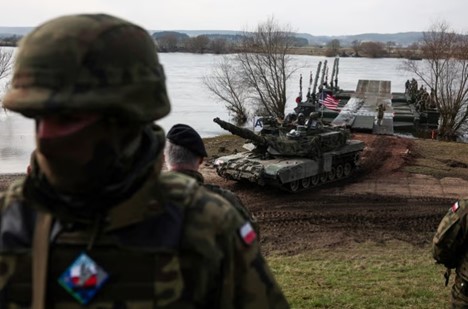
As leaders from member countries gather to mark the 75th anniversary of Nato in Washington DC, researchers are warning that their military budgets are eroding the climate, producing an estimated 233m metric tonnes of greenhouse gas, more planet-heating pollution than some entire countries.
"Our research shows that military spending increases greenhouse gas emissions, diverts critical finance from climate action, and consolidates an arms trade that fuels instability during climate breakdown," says a new report from three international research and advocacy groups, the UK-based Transnational Institute and Tipping Point North South, and the Netherlands' Stop Wapenhandel.
Nato member states poured $1.34tn into their militaries last year – an increase of $126bn from 2022, the authors say.
Military expenditure tends to be highly emitting. Aircrafts consume enormous amounts of fossil fuels, as do military bases and logistics hubs. And military equipment needs to be regularly operated and maintained to stay combat-ready – all of which produces pollution.
Overall, member states' 2023 military budgets produced some 233m metric tonnes of greenhouse gas, the authors estimate, which is more than the total annual greenhouse gas emissions of Colombia or Qatar.
"By 2030, we have to make a radical cut in emissions," said Nick Buxton. "But the biggest investment we're making worldwide, and in particularly Nato, is in military spending, which isn't just not addressing the problem, but actually worsening the problem."
Nato includes only 16% of all countries with 32 member states. Last year, members were responsible for 55% of all global military spending, with the US accounting for more than two-thirds of that total.
Nato countries' increased military expenditure will add an additional 31m metric tonnes of planet-warming emissions to the atmosphere – a surge of about 15%, or the greenhouse gas equivalent of adding 6.7m average US cars to the road for a year.
The US, whose military is already the top institutional emitter, was responsible for the largest share of the uptick with a budget increase of $55bn. It was followed by Poland, the UK and Germany, whose military budgets grew $16bn, $10.9bn and $10.7bn, respectively.
If just Nato's increase in military spending were diverted to positive climate purposes, it could fully cover the minimal climate financing for developing countries proposed at this year's United Nations climate negotiations.
The world's armed forces produce at least 5.5% of all planet-heating pollution – more than the total footprint of Japan – according to one 2022 estimate.
The United Nations' Intergovernmental Panel on Climate Change, the world's top climate body, says the world must slash emissions by 43% by 2030 to meet the more ambitious goals of the Paris agreement. Reaching that target, the researchers calculated, will require an annual reduction of military emissions of at least 5%.
But Nato countries are moving in the wrong direction. In 2023, the alliance made "an enduring commitment" to pour at least 2% of their national budgets into their militaries. Two-thirds of its members are expected to meet or exceed that target this year, up from just six countries in 2021.
Defense officials have praised these efforts as necessary for security. But the researchers say these efforts are taking a toll on the world's communities by driving global warming and diverting funds from climate finance.
If all members meet the 2% target, by 2028 they will create as much additional greenhouse gas pollution as the annual output of Russia. The additional military funds – an estimated $2.57tn – would be enough to cover low- and middle-income countries' climate adaptation costs for seven years, by United Nations Environment Programme estimates.
The true beneficiaries of the surge in defense spending, the authors say, are weapons manufacturers, who the alliance has promised to bolster various plans and pledges.
Military budget growth is not always immediately reflected in weapons manufacturers' revenues and profits as production and procurement can take years. But between 2022 and 2023, backlogs of orders at the 10 top global arms firms such as Lockheed Martin, RTX and Northrop Grumman shot up by an average of more than 13%, the researchers found – an indication of forthcoming record profits.
Some environmental safeguards are in place to hem the arms' industry's pollution, but in the US and Europe especially, those rules are increasingly being pushed aside if they are seen as barriers to increasing production, the report says.
Nato did not respond to requests for comment; the alliance has pledged to become carbon neutral by 2050.
Yet "greening" operations is not a good option, said Ho-Chih Lin of Tipping Point North South and a co-author of the report. There is "no realistic alternative energy source to wholesale replacing fossil fuels" by 2050, he said. And increasing defense spending also creates a more militarized world at a time when more cooperation and peace is needed.
Over the weekend, a coalition of activists marched in Washington DC calling for Nato to cut military spending.
In the wake of the cold war in the early 1990s, leaders in the US and Europe spoke of a "peace dividend", or a pledge to invest in social spending instead of the military. Today, Buxton said, Nato should push for a "climate peace dividend" for its members.
"There is no secure nation or alliance on an unsafe planet," he said.
Source: The Guardian – URL: https://www.theguardian.com/world/article/2024/jul/09/nato-military-co2-spending-2023-report